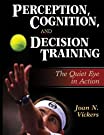by Thomas Kurz
How athletes control their gaze affects their performance–because the control of gaze is the control of attention.
Focusing your eyes means focusing your mind. Yes, your attention is where your gaze is, and as the gaze focuses, so does your attention. When your eyes wander, so does your mind. A steady gaze (“quiet eye”) on your target means a quiet, undistracted mind, and the quiet mind can direct the body to do the right thing. Different sports actions have different targets and ways of focusing on them that consistently produce peak performance.
Knowing what to focus the eyes on and when is a major factor in consistent high performance–sports mastery.
When you look at a target–an object you intend to act upon–your mind, without your awareness, is gathering and processing info about the target and preparing a program of the action (what and how to move). If you look at the wrong spot, or too late, or too briefly, the program will be wrong and your action will fail.
Researchers who studied the optimal gaze for high performance in various sports have discovered that training this gaze (the quiet eye) “leads to unusually large increases in performance” (Vickers 2007).
Now, in some sports, the target of an athlete’s gaze might not be the object the athlete has to hit, block, or catch faster than a thought–faster than it can be seen. These objects are detected in the athlete’s peripheral vision. Nevertheless, it matters where the gaze is directed–what its target is–or these faster-than-thought actions won’t happen.
You may read about it in the book Perception, Cognition, and Decision Training: The Quiet Eye in Action by Joan N. Vickers (2007). In the next article you will learn what differentiates sports experts or champions from nonexperts.
If you have any questions on training you can post them at Stadion’s Sports and Training Discussion Forum.


